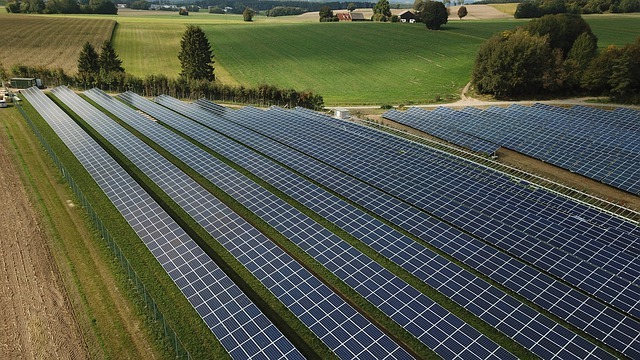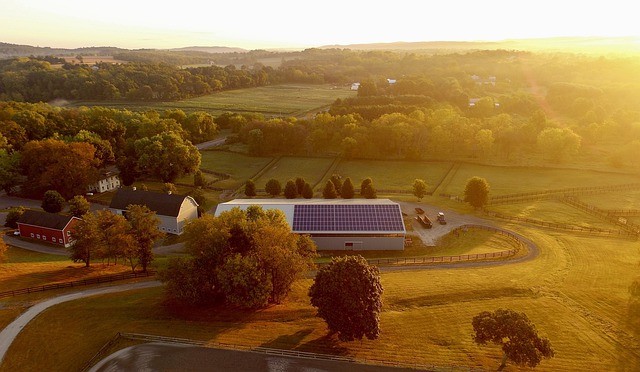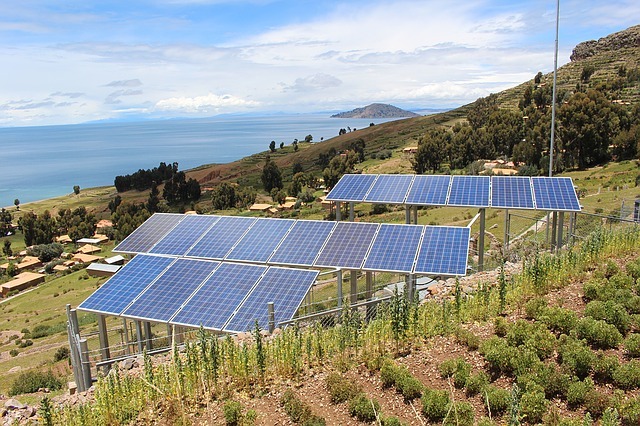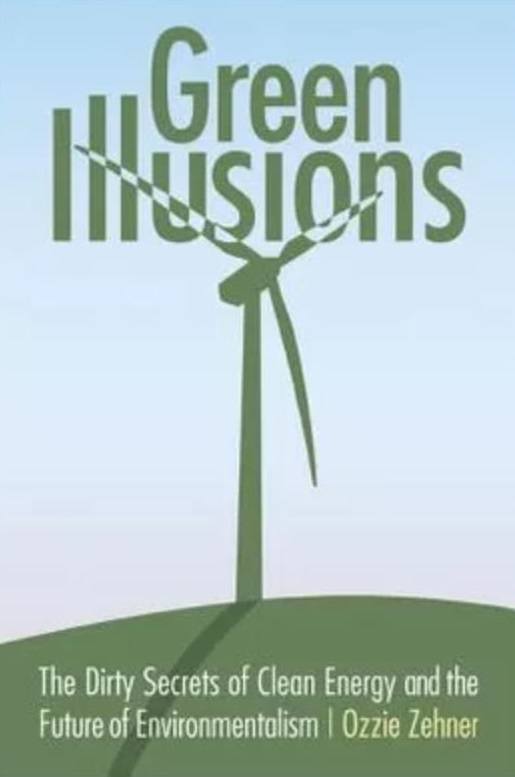What is the general situation in the world regarding renewable energy?

Photovoltaic image Samuel Faber
The boom in Solar Parks
Over the years many photovoltaic power stations have been built worldwide. Just as with other forms of green energy, there are concerns about the environmental impact solar farms might cause.
The U.S. plans big projects in the Mojave and other places. 4,600 square miles of solar farms are being planned. The idea is to have 80% renewable energy by the beginning of 2030.
The fact that these solar farms can upset the local ecosystems is not being studied well enough. One has to choose the place with care and it would be better to leave pristine locations be. Rather chose plots of land that had previously been ruined by humans already.
One should not underestimate the great amount of heat generated by these solar plants. So much that it can fry insects, and birds that happen to fly through get their feathers damaged. Additionally, when they fly through dry areas, birds might mistake the panels for a lake and crash.
Planting pollinator-friendly plants help to boost energy yield slightly as it makes the microclimate a bit cooler. Another benefit is that it reduces erosion, groundwater increases and crops are bigger.
In 15 states, they have introduced pollinator-friendly solar scorecards. It is intended to check the impact of solar farms on insects that carry pollen from one plant to the other.
The success of a solar installation depends on what kind of person has the last word. A president can make laws benefiting the environment or to the contrary, annul laws to the detriment of the environment.
President Trump did not have any feelings for the environment at all and abolished many protective laws that had been in place for many years. In his second month, he struck down a law of President Obama. If these solar projects are on federal lands, they must include a mitigation strategy. Now, this law is gone and those companies can do what they please.

Solar Farm image D Cannon
Solar farms in many countries
In 2018, 30 projects of at least 200 MW were commissioned. In 2019 there were already 35 projects and the trend is rising. The biggest solar park as of 2020, is the Bhadla Solar Park. It is situated in India’s Rajasthan Jodhpur district. It has a capacity of 2.25 GW and it covers 14,000 acres.
There are big parks in India, China, Egypt, United Arab Emirates, Mexico, United States, Vietnam, Spain, Brazil, and many more countries. Many countries have various solar parks and plan to build more. One gets the impression this is the future of green energy.
The situation in the south of Spain
Andalucía is known for its warm weather with over 320 sunshine days a year. One would think it is the ideal place for solar parks. But there are serious concerns held by the inhabitants of rural places and it is not too difficult to understand why.
First of all, there is the arrival of European funding that could well cause a boom. Solar parks are not well regulated yet.
To think that Malaga received the petition for 75 parks of which 17 were to be built in the Ronda area. The people there do not like the idea, although nobody is against renewable energy.
It is like the concept of “Not In My Backyard” but you must understand that solar parks can cause damage to the wonderful views as well as to native wildlife.
I do not know if you are familiar with Ronda and its surroundings. Here you can read my post on this beautiful city. Personally, I can see a conflict in aesthetics, mixing old with new is not always a success.

Windmills image Tomasz Jagla
Those parks are huge
A solar park can cover hundreds of hectares and the bigger the park the bigger is also its environmental impact. Companies like to avoid bureaucratic hassle and when the park is bigger than 50 megawatts (MW) they have to go from the Junta de Andalucía to the government in Madrid. That makes the whole procedure more complicated and it takes more time.
So what do they do? One company has proposed 5 different parks, each of which is 49.9 MW. That is really cheating.
The loss of fertile soil
It takes thousands of years to become fertile topsoil. But these mega parks remove it so nothing will grow there. Often land is chosen that is close to urban centers and has good accessibility but once the topsoil is gone you cannot return to its original state. That also means a loss of habitat for fauna and flora.
Spain lacks water
It is predicted that by 2050 Spain will have dried out and become one big desert. At the moment, in November 2021 the situation is not too good. Many water reservoirs are at a historical low.
Then take into consideration that these parks need a lot of water to keep the solar panels clean. In a country where there is already a scarcity, perhaps not so good.
It is not only the parks themselves that are a problem but you have to remember that each one needs high voltage lines and towers as well as other infrastructure like substations. All of this is not pretty on the eye.
In the case of Ronda and its surroundings, it might suffer a significant loss in tourism. How do you weigh the benefits vs. the detriments? After all, Ronda receives nearly 100,000 Spanish residents and some 164,000 foreign tourists per year.

Solar Panels image Adolfo Cj
The impact on wildlife and agriculture
A lot of people are concerned about the damage caused by these parks to wildlife. Wind generators, of which there are many in Spain, cause the death of birds in big numbers. Even bats fall victim to these towers.
Solar panels are also responsible for the loss of habitat for many species. It seems that green energy has a dark side as well.
One should not forget that the area of Malaga is known for its Malaga Dulce, a sweet wine that one drinks or before the meal or as an accompaniment to your dessert. It seems that some of these parks were planned in the area of the vineyards. Not a good place at all.
Be careful with the deal you make
It seems those companies can be rather aggressive, trying by all means to get the land they want. One way is to offer to rent the property with up to 1,500 Euros per hectare per year. This sounds good but the problem is that after they have gotten the project classified as being for public utility, they can apply for ownership.
Be very careful with what is in your contract as you may lose your property.
On the other hand, the councils could be forced to pay millions in fines to the developers if the contracts are not respected. This is a very tricky situation the councils try to avoid this by asking for a moratorium.
That at least gives more time to have this situation sorted out, respecting all sides.
Here is a very interesting video from China. Not only does the environment benefit hugely from this setup, but also many people find a livelihood.
An Afterthought
It seems that green energy is a must in modern times. The break from coal and nuclear power seems positive. But one has to realize that wind turbines or solar panels have their downside too.
As happens with most things, a good balance needs to be found which minimally impacts the environment.
There are various towns that have put a temporary stop to mega solar parks. Private projects that are intended for self-consumption are excluded from this suspension. Everybody seems to agree that green energy is good but more control is needed so it does not get out of hand.
Too often humans do something that has far-reaching consequences for our planet. We and the environment need to remain in balance.
Headwind is an impressive documentary
I have come across this sad film of 23 September 2021. It shows how entities, big companies, and big banks are all connected. It also shows that even if all these people talk green it is only a small part of the deal. The rest is earning money. This film is about wind parks in Sweden.
A book you should have
The writer of this book, Ozzie Zehner, suggests that we have a consumption crisis.
We think we can solve environmental problems by installing more energy farms, more solar cells, wind turbines, and biofuels-alternative technologies. These new technologies have their side effects too. We should actually try to change our behavior, but that seems difficult.
This book is practical and environmentally informed. A lucid book that argues for a change of perspective
In the last part of the book, the writer explores how future environmentalists will focus on fresh alternatives that are affordable, clean, and can actually improve our well-being.
.
.
You might care to have a look at my page Recommendations. It holds a collection of things you hopefully find interesting.
Source: Sur in English, 29th October to 4th November 2021, article by Vanessa Melga, Wikipedia
Photo Source: Pixabay
I wrote the following post before Covid-19. Already at that time, there were protests because of Climate Change. Glasgow COP 26 is on its way but once again I think nothing tangible will come out of it. Anyhow, time will tell.
You might like to read my post on disappearing songbirds.










Comments
Edwin Bernard
I feel that laying solar farms in the desert makes the most sense. When they are laid in agricultural areas on the ground, that can be an issue, as you discussed. I didn’t realize that when birds flew over them they had such a deleterious effect on them. I thought that solar farms created with mirrors directing the sun’s energy towards a boiler were dangerous to birds.
We have solar panels on our roof. The law in California requires that ALL new residential construction must be built with solar panels on the roof. I have noticed that parking lots now erect shade structures for the cars and place solar panels on the roof.
However, I see a major environmental problem brewing for the future. After 25 years, the efficiency of solar panels drops to 85%. From that point, there is a slow decline. Eventually, they will not be efficient enough economically and will need replacement. What is going to happen with the old solar panels? They can be toxic. People have to plan for when that occurs. And I don’t see that happening.
Taetske
Good afternoon Edwin,
Thank you for your visit and for your comment. I hope you downloaded a free PDF of your choice at the Tulip widget.
I find it very sad that all we humans do, or not do, have, most of the time, serious side effects. Is it that things are not thought out enough, lack of deep-going study and mainly focus on the money side of it? I think it is a great idea that house roofs or any other kind of roofs in the community are used for solar panels. As far as I know, they do not present a big hazard to nature.
You mention that solar panels can be toxic and in the future need a plan to eliminate without damaging the environment. I am afraid there will be no plan and whatever is done will not be good. Think about nuclear waste contamination of the earth and groundwater. We have just seen what happened in Glasgow, nothing. All this reminds me of the YouTube video Man by Steve Cutts, one of my favorites. When the aliens arrive they will be horrified at what we did to Mother Earth.
Regards,
Taetske
Valerie
I can’t bear the thought of birds being hurt. They are the most beautiful creatures. Birds have always been a big part of my life due to my father being a bird lover and having pigeons, budgerigars and canaries as well as Hens, Roosters, Chickens and more! Nowadays, I watch and listen to the birds in my garden. They tweet as they walk among the plants and flitter in flight from one tree to another. They are nothing other than beautiful.
My way of thinking is that the entire world is in turmoil as to the future. Will there be clean fresh air for our descendants to breathe? There is so much planning but how much positive action takes place, I do not know. Then again, what will be the result of any action with regard to the human race? At least humans are able to speak for themselves, whereas wildlife has no voice.
I was not aware of Spain lacking water. That doesn’t bear thinking about! I know that sea levels are diminishing, possibly worldwide. I have never visited Spain but I’ve been told much about its beauty by a Spanish family, and friends who have travelled there on holiday.
You provide wonderful information in this article, Taetske. There is so much detail to absorb in the short space of time I have to visit your website today. I will return to your post and learn more from your articles.
Taetske
Good afternoon Valerie,
Thank you for stopping by and for your comment. I hope you downloaded a PDF of your choice at the Tulip widget
My parents had a lovely garden in Holland. I enjoyed watching all the happenings. My Mother would prepare special bird food for the sometimes severe winters. Once a squirrel got entangled in the hanging wire of the small platform. My Mother put on garden gloves and was able to free the poor animal after a heavy battle.
She also had a list of birds that would be there year-round, around 40 different ones, and then the birds that would pop in while on emigration, another 40. Nowadays you will not have that luck anymore.
Here on my organic farm in the south of Spain, I do have a lot of different birds but the list is much shorter than the one my Mother made. Of course, that was in the 50s, 60s, 70s, but it is sad so many have gone missing over the years.
The fact that Spain is drying out also contributes to bird loss. In the south, there is a famous National Park called Donana with one of the most important wetlands in Europe. Here the emigration birds have their stopover. Pink Flamingos have their babies. Too little rain is slowly drying out these lands, a real catastrophe. Modern inventions often have severe side effects and fauna and flora suffer.
Regards,
Taetske